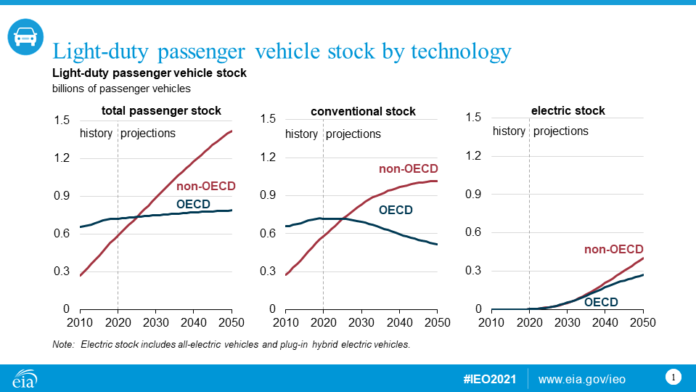In its International Energy Outlook 2021, the U.S. Energy Information Administration (EIA) estimates the global light-duty vehicle (LDV) fleet contained 1.31 billion vehicles in 2020. It projects this fleet will grow to 2.21 billion vehicles by 2050, and electric vehicles (EV) – any LDV with a charging plug – will grow from 0.7% of the global LDV fleet in 2020 to 31% in 2050, reaching 672 million vehicles.
Significant growth in EV sales and shares of sales through the projection period results in the global conventional gasoline and diesel LDV fleet peaking in 2038.
EIA projects that an increase in economic activity, population and private mobility will result in more global LDVs through 2050. The population of non-OECD (Organization for Economic Cooperation and Development) countries will grow at over three times the population growth rate of OECD countries and that the non-OECD motorization rate will increase from 92 vehicles per thousand people to 173 vehicles per thousand people between 2020 and 2050.
The OECD countries’ motorization rate remains around 530 vehicles per thousand people through the projection period. Because of this growth in population and motorization rates, EIA projects the number of LDVs in non-OECD countries will surpass those in OECD countries in 2025.
The 2020 global LDV fleet primarily consists of conventional gasoline and diesel internal combustion engine vehicles, but sales of EVs are projected to grow due to recent technology and policy developments. In EIA’s International Energy Outlook 2021, EVs include both full battery, all-electric vehicles and plug-in hybrid electric vehicles that are primarily powered by liquid fuels when batteries are nearly depleted.
EIA also projects EV fleet shares will reach 34% in OECD countries and 28% in non-OECD countries by 2050. Although the conventional LDV fleet peaks in 2023 for OECD countries, faster growth in the non-OECD fleet results in nearly two-thirds of light-duty EVs being in non-OECD countries by 2050.





